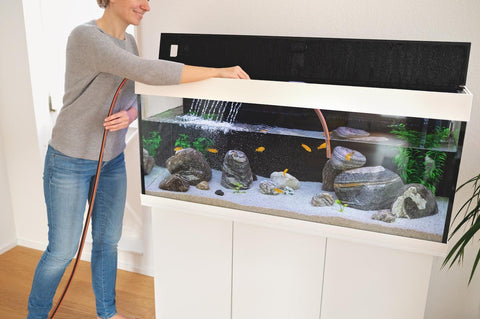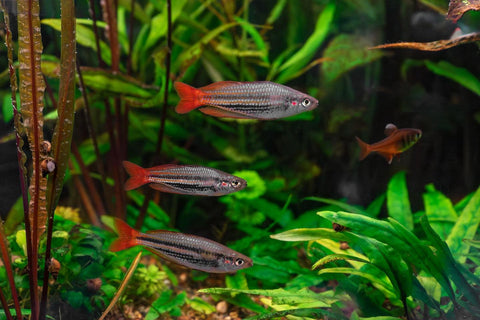Regular water changes are an important part of aquarium care. It serves to maintain the water quality and ensure the well-being of the fish and plants. But how often should you actually change the water in your aquarium?
The frequency of water changes depends on various factors, such as the size of the aquarium, the number of inhabitants and the type of filtration. Here are some guidelines that can help you determine the optimal interval for water changes:
- Weekly water change: In most cases, it is recommended to clean the aquarium once a week and partially change the water. A water change of around 20-30% of the total volume is sufficient to remove pollutants and waste products.
- Monthly water change: For larger aquariums with a stable water chemistry, a monthly water change may be sufficient. However, a larger percentage, around 30-40% of the water, should be changed to ensure sufficient cleaning.
- Water quality monitoring: Regardless of the general recommendations, it is important to check the water quality regularly. If the water is cloudy, smells unpleasant or has high levels of pollutants, you should carry out a water change, regardless of the time that has passed since the last change.
It is also important to note that the water change not only affects the water itself, but also the filter and the substrate. By cleaning the filter and vacuuming dirt and debris from the substrate, you can further improve the water quality.
Regular water changes are crucial for a healthy and stable aquarium. It helps to remove pollutants, regulate pH levels and provide optimal living conditions for fish and plants. By following the above guidelines and checking the water quality regularly, you can ensure that your aquarium remains clean and healthy.
Why is it important to change the water regularly
Water quality is of crucial importance for the well-being of aquarium inhabitants. Over time, pollutants accumulate in the water, such as nitrate, phosphate and ammonia, which can be toxic to fish and plants. Regular water changes help to remove these pollutants and create a healthy environment for the inhabitants.
Another important aspect of water changes is regulating the pH value in the aquarium. A high pH can lead to alkaline conditions, while a low pH causes acidic conditions. Both extremes can be harmful to the fish and plants. By changing the water regularly, you can stabilize the pH value and maintain an optimal balance in the aquarium.
In addition to removing harmful substances and regulating the pH, changing the water also promotes the growth and health of plants. Plants in the aquarium play an important role in absorbing excess nitrate and phosphate, which could otherwise lead to algae growth. Regular water changes support the plants in their function as natural filters and therefore help to combat algae.
How to carry out a water change
Before you carry out the water change, you should make sure you have the right tools and materials. You will need a bucket or hose to drain the old water and a water conditioner to prepare the new water.
The process of changing the water consists of the following steps:
- Fill the bucket with fresh tap water and add the water conditioner according to the instructions. The water conditioner removes harmful chlorine and chloramine residues and prepares the water for use in the aquarium.
- Use the hose or bucket to drain the old water from the aquarium. You can also vacuum the substrate with a mulch bucket to remove dirt and debris.
- Carefully pour the prepared water into the aquarium. Make sure that the temperature of the new water is the same as that of the aquarium to avoid temperature shocks.
- Make sure that the filter and other equipment are working properly and that the water parameters are stable. Also regularly check the pH value and other relevant water values.
It is important not to neglect water changes or to carry them out too frequently. Changing the water too frequently can disrupt the biological balance in the aquarium and cause stress for the inhabitants. Follow the recommended guidelines and monitor the water quality to determine the optimum interval for your specific case.
By regularly changing the water in the aquarium and monitoring the water quality, you can ensure that your fish and plants have a clean and healthy environment. Regular water changes are a simple but important step in maintaining a successful and thriving aquarium.
Tips for maintaining your aquarium
Aside from changing the water, there are other aspects you should consider when caring for your aquarium:
- Feeding: Make sure you feed your fish appropriately to avoid overfeeding and an excessive accumulation of leftover food. This can have a negative impact on water quality.
- Lighting: Make sure that the lighting in the aquarium meets the needs of the inhabitants. Plants require an appropriate lighting duration, while some fish species can react sensitively to light that is too bright.
- Plant care: Trim overgrown plants regularly and remove dead leaves. This enables better water circulation and prevents plants from overgrowing the aquarium.
- Water parameters: Regularly monitor the water parameters such as the pH value, temperature, nitrate content and ammonia content. Make sure that the values are within the acceptable range for the inhabitants.
- Algae control: Keep algae growth under control by protecting the aquarium from excessive light, keeping the substrate clean and optimizing the water quality.
By following these tips and taking good care of your aquarium, you can ensure that it provides a healthy and beautiful home for your fish and plants. Remember that every aquarium is individual and it is important to consider the needs of your inhabitants. With the right care and attention, your aquarium will thrive and give you years of enjoyment.




Comments (0)
There are no comments for this article. Be the first one to leave a message!